Nursing Theories for Clinical Decision Making: A Case Study on Multiple Sclerosis
VerifiedAdded on 2023/06/07
|10
|3049
|339
AI Summary
This assignment discusses how Miller's theory of functional consequences and clinical reasoning cycle can guide nurses in providing safe and quality care to patients with Multiple Sclerosis. It includes a case study of an 83-year-old patient suffering from mobility issues due to Multiple Sclerosis and how nursing priorities were identified and addressed. The article also discusses the disorder of Multiple Sclerosis, its symptoms, and the interventions that can be taken to manage it.
Contribute Materials
Your contribution can guide someone’s learning journey. Share your
documents today.
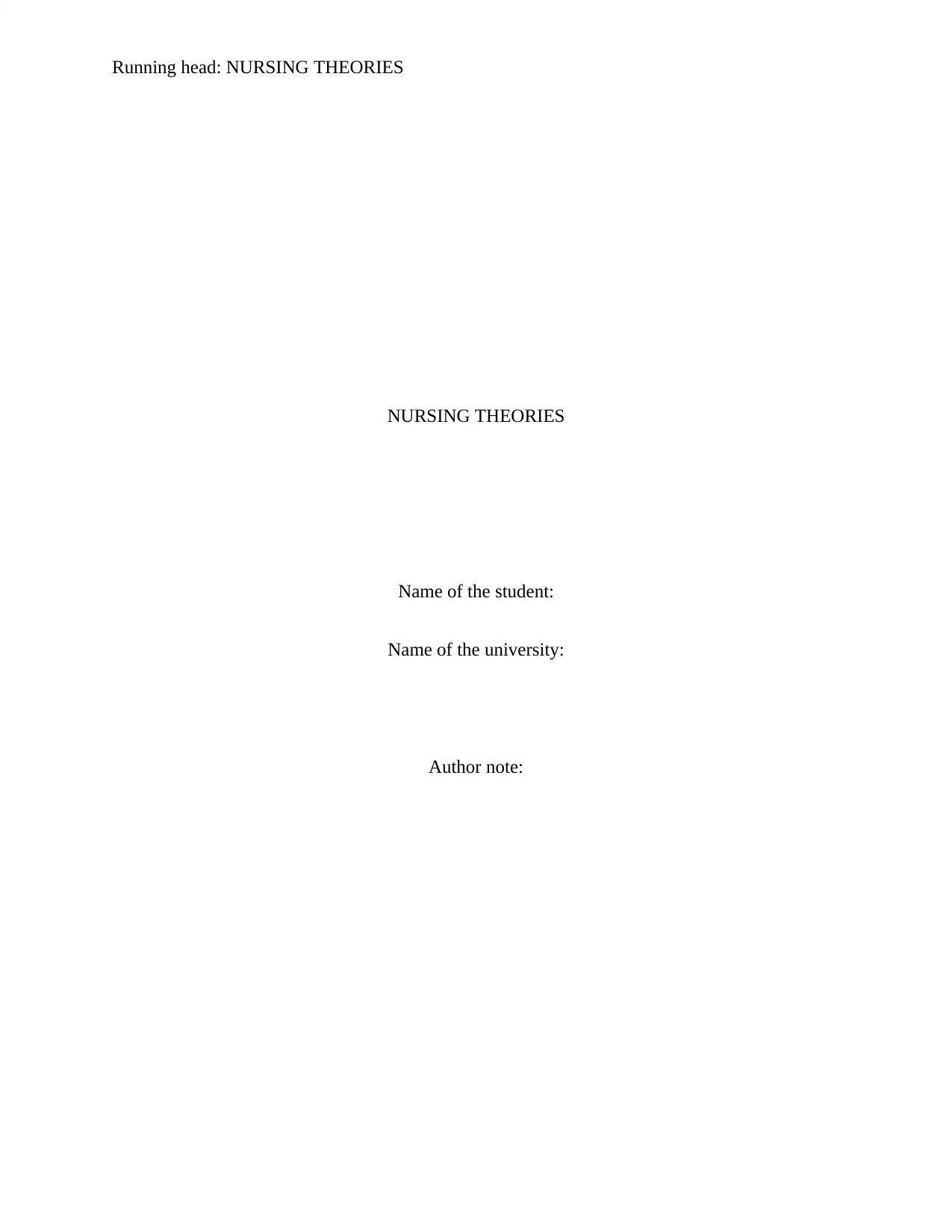
Running head: NURSING THEORIES
NURSING THEORIES
Name of the student:
Name of the university:
Author note:
NURSING THEORIES
Name of the student:
Name of the university:
Author note:
Secure Best Marks with AI Grader
Need help grading? Try our AI Grader for instant feedback on your assignments.
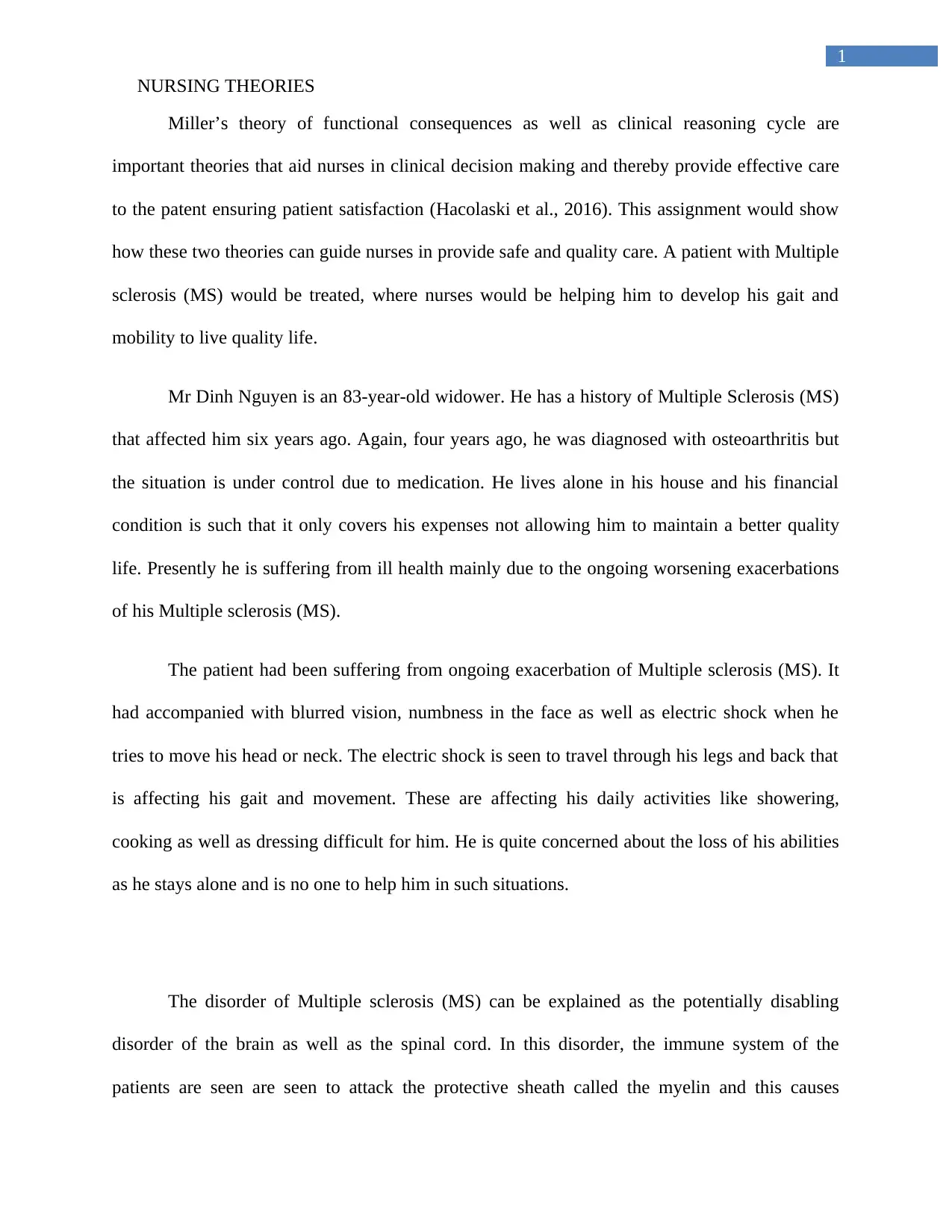
1
NURSING THEORIES
Miller’s theory of functional consequences as well as clinical reasoning cycle are
important theories that aid nurses in clinical decision making and thereby provide effective care
to the patent ensuring patient satisfaction (Hacolaski et al., 2016). This assignment would show
how these two theories can guide nurses in provide safe and quality care. A patient with Multiple
sclerosis (MS) would be treated, where nurses would be helping him to develop his gait and
mobility to live quality life.
Mr Dinh Nguyen is an 83-year-old widower. He has a history of Multiple Sclerosis (MS)
that affected him six years ago. Again, four years ago, he was diagnosed with osteoarthritis but
the situation is under control due to medication. He lives alone in his house and his financial
condition is such that it only covers his expenses not allowing him to maintain a better quality
life. Presently he is suffering from ill health mainly due to the ongoing worsening exacerbations
of his Multiple sclerosis (MS).
The patient had been suffering from ongoing exacerbation of Multiple sclerosis (MS). It
had accompanied with blurred vision, numbness in the face as well as electric shock when he
tries to move his head or neck. The electric shock is seen to travel through his legs and back that
is affecting his gait and movement. These are affecting his daily activities like showering,
cooking as well as dressing difficult for him. He is quite concerned about the loss of his abilities
as he stays alone and is no one to help him in such situations.
The disorder of Multiple sclerosis (MS) can be explained as the potentially disabling
disorder of the brain as well as the spinal cord. In this disorder, the immune system of the
patients are seen are seen to attack the protective sheath called the myelin and this causes
NURSING THEORIES
Miller’s theory of functional consequences as well as clinical reasoning cycle are
important theories that aid nurses in clinical decision making and thereby provide effective care
to the patent ensuring patient satisfaction (Hacolaski et al., 2016). This assignment would show
how these two theories can guide nurses in provide safe and quality care. A patient with Multiple
sclerosis (MS) would be treated, where nurses would be helping him to develop his gait and
mobility to live quality life.
Mr Dinh Nguyen is an 83-year-old widower. He has a history of Multiple Sclerosis (MS)
that affected him six years ago. Again, four years ago, he was diagnosed with osteoarthritis but
the situation is under control due to medication. He lives alone in his house and his financial
condition is such that it only covers his expenses not allowing him to maintain a better quality
life. Presently he is suffering from ill health mainly due to the ongoing worsening exacerbations
of his Multiple sclerosis (MS).
The patient had been suffering from ongoing exacerbation of Multiple sclerosis (MS). It
had accompanied with blurred vision, numbness in the face as well as electric shock when he
tries to move his head or neck. The electric shock is seen to travel through his legs and back that
is affecting his gait and movement. These are affecting his daily activities like showering,
cooking as well as dressing difficult for him. He is quite concerned about the loss of his abilities
as he stays alone and is no one to help him in such situations.
The disorder of Multiple sclerosis (MS) can be explained as the potentially disabling
disorder of the brain as well as the spinal cord. In this disorder, the immune system of the
patients are seen are seen to attack the protective sheath called the myelin and this causes
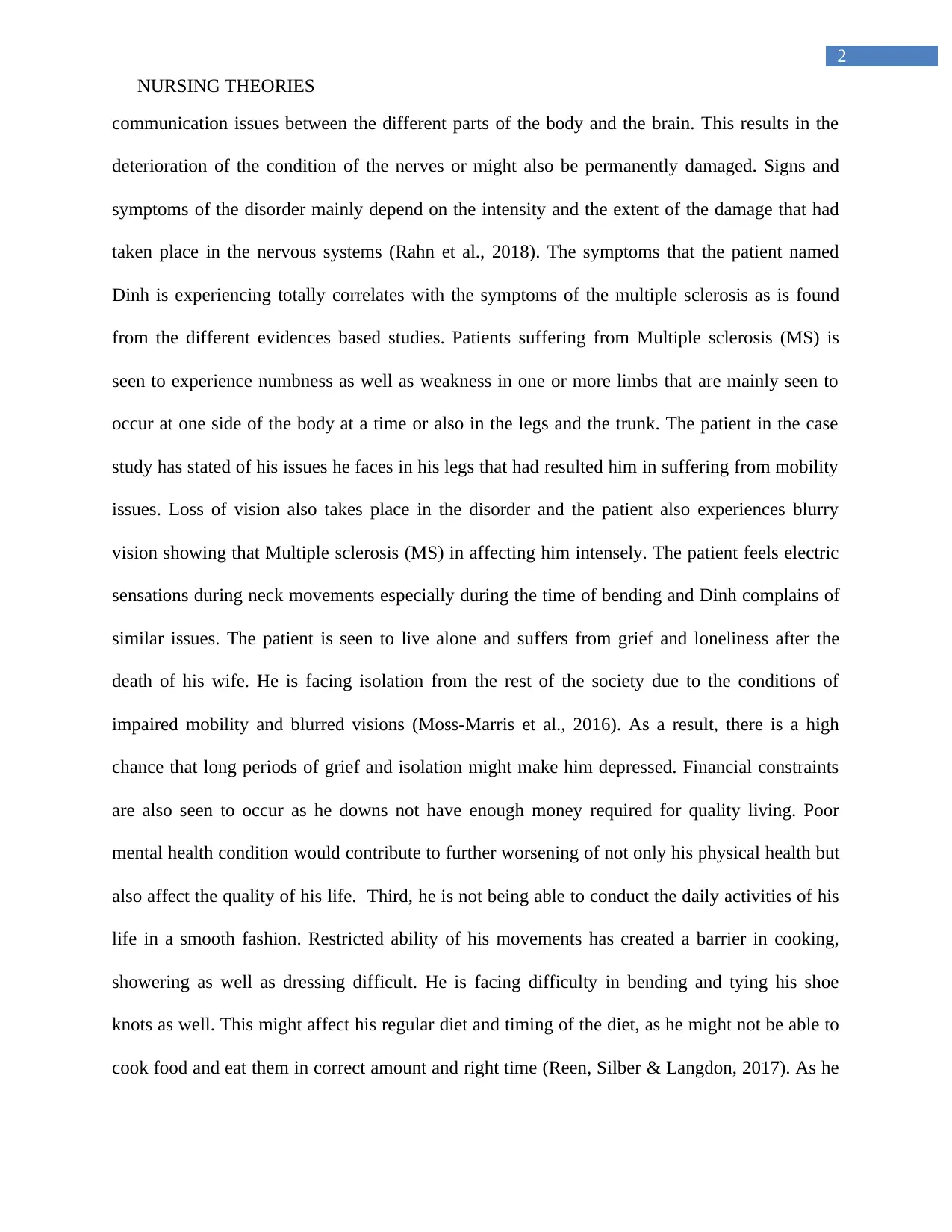
2
NURSING THEORIES
communication issues between the different parts of the body and the brain. This results in the
deterioration of the condition of the nerves or might also be permanently damaged. Signs and
symptoms of the disorder mainly depend on the intensity and the extent of the damage that had
taken place in the nervous systems (Rahn et al., 2018). The symptoms that the patient named
Dinh is experiencing totally correlates with the symptoms of the multiple sclerosis as is found
from the different evidences based studies. Patients suffering from Multiple sclerosis (MS) is
seen to experience numbness as well as weakness in one or more limbs that are mainly seen to
occur at one side of the body at a time or also in the legs and the trunk. The patient in the case
study has stated of his issues he faces in his legs that had resulted him in suffering from mobility
issues. Loss of vision also takes place in the disorder and the patient also experiences blurry
vision showing that Multiple sclerosis (MS) in affecting him intensely. The patient feels electric
sensations during neck movements especially during the time of bending and Dinh complains of
similar issues. The patient is seen to live alone and suffers from grief and loneliness after the
death of his wife. He is facing isolation from the rest of the society due to the conditions of
impaired mobility and blurred visions (Moss-Marris et al., 2016). As a result, there is a high
chance that long periods of grief and isolation might make him depressed. Financial constraints
are also seen to occur as he downs not have enough money required for quality living. Poor
mental health condition would contribute to further worsening of not only his physical health but
also affect the quality of his life. Third, he is not being able to conduct the daily activities of his
life in a smooth fashion. Restricted ability of his movements has created a barrier in cooking,
showering as well as dressing difficult. He is facing difficulty in bending and tying his shoe
knots as well. This might affect his regular diet and timing of the diet, as he might not be able to
cook food and eat them in correct amount and right time (Reen, Silber & Langdon, 2017). As he
NURSING THEORIES
communication issues between the different parts of the body and the brain. This results in the
deterioration of the condition of the nerves or might also be permanently damaged. Signs and
symptoms of the disorder mainly depend on the intensity and the extent of the damage that had
taken place in the nervous systems (Rahn et al., 2018). The symptoms that the patient named
Dinh is experiencing totally correlates with the symptoms of the multiple sclerosis as is found
from the different evidences based studies. Patients suffering from Multiple sclerosis (MS) is
seen to experience numbness as well as weakness in one or more limbs that are mainly seen to
occur at one side of the body at a time or also in the legs and the trunk. The patient in the case
study has stated of his issues he faces in his legs that had resulted him in suffering from mobility
issues. Loss of vision also takes place in the disorder and the patient also experiences blurry
vision showing that Multiple sclerosis (MS) in affecting him intensely. The patient feels electric
sensations during neck movements especially during the time of bending and Dinh complains of
similar issues. The patient is seen to live alone and suffers from grief and loneliness after the
death of his wife. He is facing isolation from the rest of the society due to the conditions of
impaired mobility and blurred visions (Moss-Marris et al., 2016). As a result, there is a high
chance that long periods of grief and isolation might make him depressed. Financial constraints
are also seen to occur as he downs not have enough money required for quality living. Poor
mental health condition would contribute to further worsening of not only his physical health but
also affect the quality of his life. Third, he is not being able to conduct the daily activities of his
life in a smooth fashion. Restricted ability of his movements has created a barrier in cooking,
showering as well as dressing difficult. He is facing difficulty in bending and tying his shoe
knots as well. This might affect his regular diet and timing of the diet, as he might not be able to
cook food and eat them in correct amount and right time (Reen, Silber & Langdon, 2017). As he
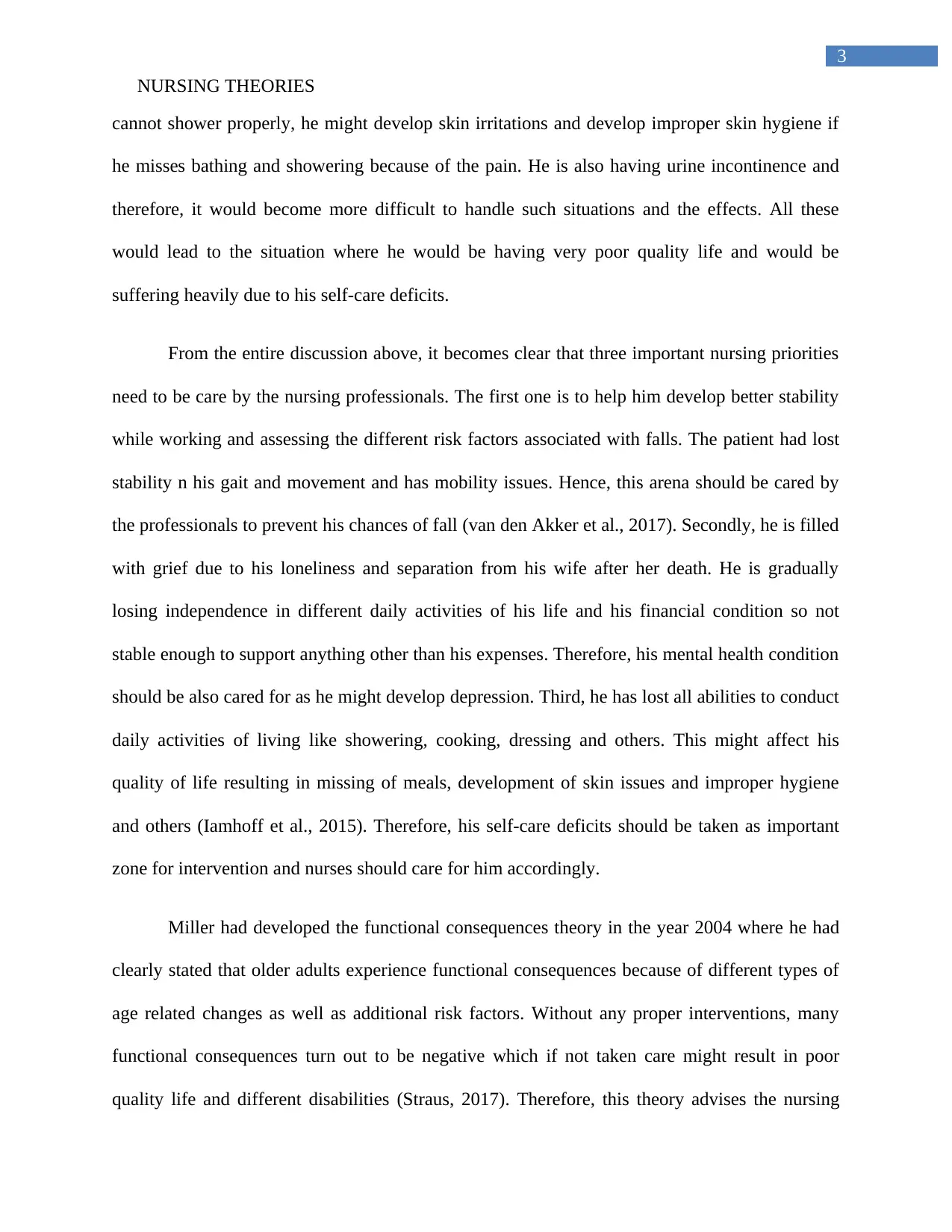
3
NURSING THEORIES
cannot shower properly, he might develop skin irritations and develop improper skin hygiene if
he misses bathing and showering because of the pain. He is also having urine incontinence and
therefore, it would become more difficult to handle such situations and the effects. All these
would lead to the situation where he would be having very poor quality life and would be
suffering heavily due to his self-care deficits.
From the entire discussion above, it becomes clear that three important nursing priorities
need to be care by the nursing professionals. The first one is to help him develop better stability
while working and assessing the different risk factors associated with falls. The patient had lost
stability n his gait and movement and has mobility issues. Hence, this arena should be cared by
the professionals to prevent his chances of fall (van den Akker et al., 2017). Secondly, he is filled
with grief due to his loneliness and separation from his wife after her death. He is gradually
losing independence in different daily activities of his life and his financial condition so not
stable enough to support anything other than his expenses. Therefore, his mental health condition
should be also cared for as he might develop depression. Third, he has lost all abilities to conduct
daily activities of living like showering, cooking, dressing and others. This might affect his
quality of life resulting in missing of meals, development of skin issues and improper hygiene
and others (Iamhoff et al., 2015). Therefore, his self-care deficits should be taken as important
zone for intervention and nurses should care for him accordingly.
Miller had developed the functional consequences theory in the year 2004 where he had
clearly stated that older adults experience functional consequences because of different types of
age related changes as well as additional risk factors. Without any proper interventions, many
functional consequences turn out to be negative which if not taken care might result in poor
quality life and different disabilities (Straus, 2017). Therefore, this theory advises the nursing
NURSING THEORIES
cannot shower properly, he might develop skin irritations and develop improper skin hygiene if
he misses bathing and showering because of the pain. He is also having urine incontinence and
therefore, it would become more difficult to handle such situations and the effects. All these
would lead to the situation where he would be having very poor quality life and would be
suffering heavily due to his self-care deficits.
From the entire discussion above, it becomes clear that three important nursing priorities
need to be care by the nursing professionals. The first one is to help him develop better stability
while working and assessing the different risk factors associated with falls. The patient had lost
stability n his gait and movement and has mobility issues. Hence, this arena should be cared by
the professionals to prevent his chances of fall (van den Akker et al., 2017). Secondly, he is filled
with grief due to his loneliness and separation from his wife after her death. He is gradually
losing independence in different daily activities of his life and his financial condition so not
stable enough to support anything other than his expenses. Therefore, his mental health condition
should be also cared for as he might develop depression. Third, he has lost all abilities to conduct
daily activities of living like showering, cooking, dressing and others. This might affect his
quality of life resulting in missing of meals, development of skin issues and improper hygiene
and others (Iamhoff et al., 2015). Therefore, his self-care deficits should be taken as important
zone for intervention and nurses should care for him accordingly.
Miller had developed the functional consequences theory in the year 2004 where he had
clearly stated that older adults experience functional consequences because of different types of
age related changes as well as additional risk factors. Without any proper interventions, many
functional consequences turn out to be negative which if not taken care might result in poor
quality life and different disabilities (Straus, 2017). Therefore, this theory advises the nursing
Secure Best Marks with AI Grader
Need help grading? Try our AI Grader for instant feedback on your assignments.

4
NURSING THEORIES
professionals to identify the factor that causes negative functional consequences and thereby help
in initiating interventions that help in providing positive outcomes. This theory supports and
encourages the nursing professionals for helping the aging person to experience the health
fulfillment and thereby develop a sense of well being. It is the duty of the nurses to be aware
whether the changes that are affecting the patients are because of the aging as well as diseases
condition (Miller, 2018).
Therefore, it is very important for the nurses to identify that of the most important
concern like that of the loss of the ability of the movement in the patient is because of disorder r
due to aging. By applying this theory, it is identified that the loss of the ability of the patient in
his mobility is mainly because of the exacerbation of the disorder of Multiple sclerosis (MS).
Movement of the normal individuals mainly takes place as result of the coordinated as well as
efficient muscle contraction where necessary muscles, nerves, joints all act together (Gu et al.,
2015). The coordination of the muscle mainly takes place because of the integrated nervous
systems, brain, skeletal and spinal cord functions. Along with it, cerebellum is seen to process
the information that helps in allowing the more fine-scale, precise movements. However, in case
of the Multiple sclerosis (MS), messages are not transmitted properly. This is mainly because the
paths between the rain, as well as the spinal cord and the muscles get damaged. Because of this,
the messages get scrambled and therefore, several muscle groups are seen to contract at the same
time when they should not do so. Researchers are of the opinion that because of this reason,
precise more control is lost progressively. Simultaneous contraction of the flexor as well as the
extensor muscles are seen to lead to a lack of coordination that associates with painful and
debilitating results (Norman et al., 2017). Loss of mobility is mainly results from the progressive
degradation of the myelin and hence of the different nerve fibers. This causes disruption of the
NURSING THEORIES
professionals to identify the factor that causes negative functional consequences and thereby help
in initiating interventions that help in providing positive outcomes. This theory supports and
encourages the nursing professionals for helping the aging person to experience the health
fulfillment and thereby develop a sense of well being. It is the duty of the nurses to be aware
whether the changes that are affecting the patients are because of the aging as well as diseases
condition (Miller, 2018).
Therefore, it is very important for the nurses to identify that of the most important
concern like that of the loss of the ability of the movement in the patient is because of disorder r
due to aging. By applying this theory, it is identified that the loss of the ability of the patient in
his mobility is mainly because of the exacerbation of the disorder of Multiple sclerosis (MS).
Movement of the normal individuals mainly takes place as result of the coordinated as well as
efficient muscle contraction where necessary muscles, nerves, joints all act together (Gu et al.,
2015). The coordination of the muscle mainly takes place because of the integrated nervous
systems, brain, skeletal and spinal cord functions. Along with it, cerebellum is seen to process
the information that helps in allowing the more fine-scale, precise movements. However, in case
of the Multiple sclerosis (MS), messages are not transmitted properly. This is mainly because the
paths between the rain, as well as the spinal cord and the muscles get damaged. Because of this,
the messages get scrambled and therefore, several muscle groups are seen to contract at the same
time when they should not do so. Researchers are of the opinion that because of this reason,
precise more control is lost progressively. Simultaneous contraction of the flexor as well as the
extensor muscles are seen to lead to a lack of coordination that associates with painful and
debilitating results (Norman et al., 2017). Loss of mobility is mainly results from the progressive
degradation of the myelin and hence of the different nerve fibers. This causes disruption of the

5
NURSING THEORIES
transmission of the nerve signals to the muscles that helps in mobility. Therefore, these muscles
do not get the appropriate orders to contract. Damage occurring in the upper motor neurons (that
control the reflexes and muscle tone) results in generating continuous muscles contraction. These
affect the joint reflex. Hence, the nursing professionals after indentifying that the loss of mobility
is due to disorder and not due to aging, they need to take effective steps to ensure that the old
patients lives quality life according to Miller’s functional consequences theory (Deschênes &
Goudreau, 2017).
The main goal of the treatment would be the maximization of the quality of the life of the
patient mainly by managing the different symptoms, shortening of specific exacerbations and
thereby ensuring slowing of the progression of the disorder. The main goals would be managing
his mobility issues so that he can develop a stable gait, conduct his daily activities, gain some
degree of independence and can interact with society, friends and families and overcome the
feeling of isolation.
Immunotherapy treatments should be initiated and maintained which would help in
slowing down the frequency as well as the severity of the patient. Researchers often state
corticosteroids to be used that help the individual from recovering from Multiple sclerosis (MS).
Physicians can also advise for different medications like muscle relaxants according to the
degree and intensity of the condition of the patient. One of the most important interventions that
nurses should also conduct is the arrangement of physiotherapists along with other medications
that would help in the treatment of the muscle problems (Lubarsky et al., 2015). These would
help in the easing out of the spasms, stiffness and tremors. The professionals would also help in
providing exercise programs. This will improve the strength, balance as well as coordination and
flexibility of the individual. Occupational therapists should also be referred, as they would help
NURSING THEORIES
transmission of the nerve signals to the muscles that helps in mobility. Therefore, these muscles
do not get the appropriate orders to contract. Damage occurring in the upper motor neurons (that
control the reflexes and muscle tone) results in generating continuous muscles contraction. These
affect the joint reflex. Hence, the nursing professionals after indentifying that the loss of mobility
is due to disorder and not due to aging, they need to take effective steps to ensure that the old
patients lives quality life according to Miller’s functional consequences theory (Deschênes &
Goudreau, 2017).
The main goal of the treatment would be the maximization of the quality of the life of the
patient mainly by managing the different symptoms, shortening of specific exacerbations and
thereby ensuring slowing of the progression of the disorder. The main goals would be managing
his mobility issues so that he can develop a stable gait, conduct his daily activities, gain some
degree of independence and can interact with society, friends and families and overcome the
feeling of isolation.
Immunotherapy treatments should be initiated and maintained which would help in
slowing down the frequency as well as the severity of the patient. Researchers often state
corticosteroids to be used that help the individual from recovering from Multiple sclerosis (MS).
Physicians can also advise for different medications like muscle relaxants according to the
degree and intensity of the condition of the patient. One of the most important interventions that
nurses should also conduct is the arrangement of physiotherapists along with other medications
that would help in the treatment of the muscle problems (Lubarsky et al., 2015). These would
help in the easing out of the spasms, stiffness and tremors. The professionals would also help in
providing exercise programs. This will improve the strength, balance as well as coordination and
flexibility of the individual. Occupational therapists should also be referred, as they would help
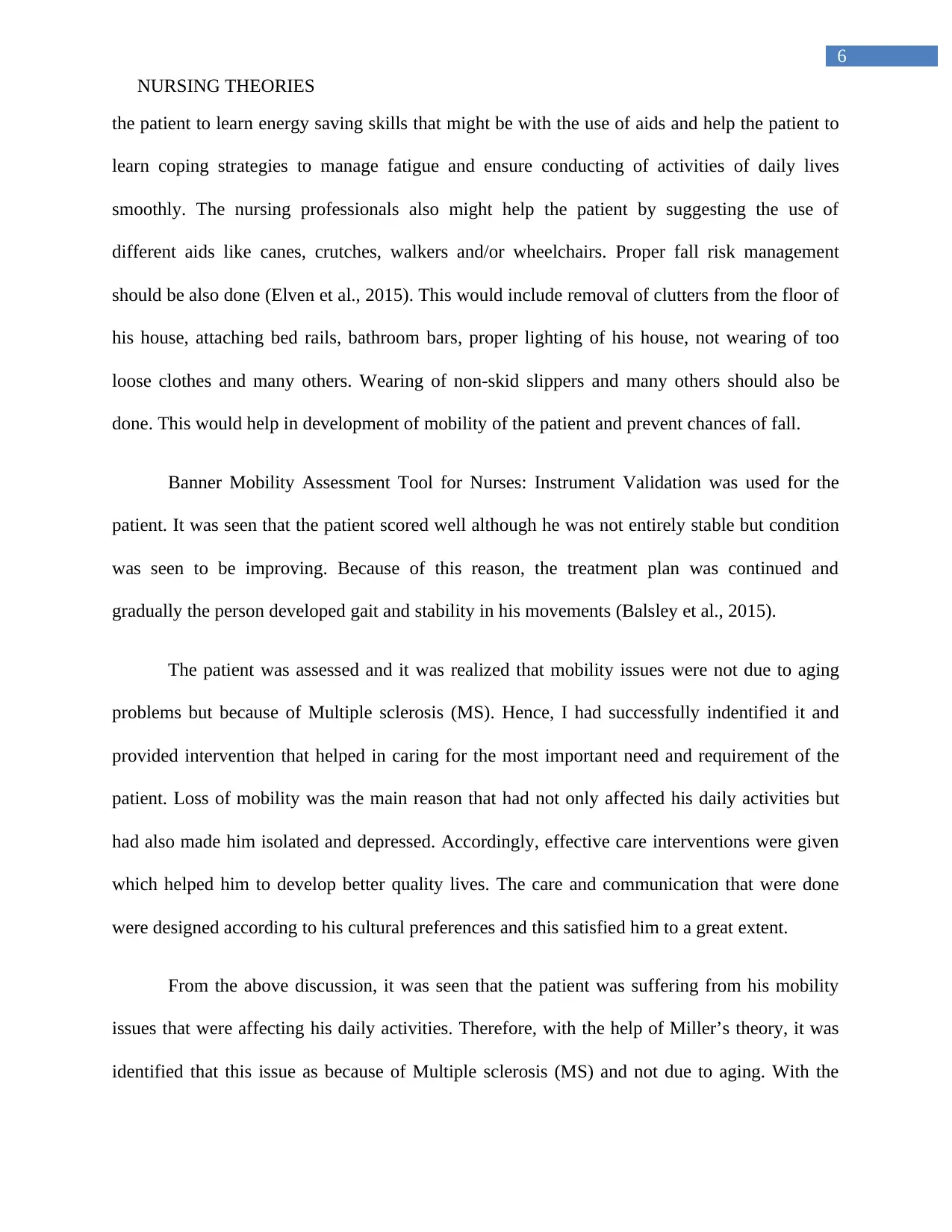
6
NURSING THEORIES
the patient to learn energy saving skills that might be with the use of aids and help the patient to
learn coping strategies to manage fatigue and ensure conducting of activities of daily lives
smoothly. The nursing professionals also might help the patient by suggesting the use of
different aids like canes, crutches, walkers and/or wheelchairs. Proper fall risk management
should be also done (Elven et al., 2015). This would include removal of clutters from the floor of
his house, attaching bed rails, bathroom bars, proper lighting of his house, not wearing of too
loose clothes and many others. Wearing of non-skid slippers and many others should also be
done. This would help in development of mobility of the patient and prevent chances of fall.
Banner Mobility Assessment Tool for Nurses: Instrument Validation was used for the
patient. It was seen that the patient scored well although he was not entirely stable but condition
was seen to be improving. Because of this reason, the treatment plan was continued and
gradually the person developed gait and stability in his movements (Balsley et al., 2015).
The patient was assessed and it was realized that mobility issues were not due to aging
problems but because of Multiple sclerosis (MS). Hence, I had successfully indentified it and
provided intervention that helped in caring for the most important need and requirement of the
patient. Loss of mobility was the main reason that had not only affected his daily activities but
had also made him isolated and depressed. Accordingly, effective care interventions were given
which helped him to develop better quality lives. The care and communication that were done
were designed according to his cultural preferences and this satisfied him to a great extent.
From the above discussion, it was seen that the patient was suffering from his mobility
issues that were affecting his daily activities. Therefore, with the help of Miller’s theory, it was
identified that this issue as because of Multiple sclerosis (MS) and not due to aging. With the
NURSING THEORIES
the patient to learn energy saving skills that might be with the use of aids and help the patient to
learn coping strategies to manage fatigue and ensure conducting of activities of daily lives
smoothly. The nursing professionals also might help the patient by suggesting the use of
different aids like canes, crutches, walkers and/or wheelchairs. Proper fall risk management
should be also done (Elven et al., 2015). This would include removal of clutters from the floor of
his house, attaching bed rails, bathroom bars, proper lighting of his house, not wearing of too
loose clothes and many others. Wearing of non-skid slippers and many others should also be
done. This would help in development of mobility of the patient and prevent chances of fall.
Banner Mobility Assessment Tool for Nurses: Instrument Validation was used for the
patient. It was seen that the patient scored well although he was not entirely stable but condition
was seen to be improving. Because of this reason, the treatment plan was continued and
gradually the person developed gait and stability in his movements (Balsley et al., 2015).
The patient was assessed and it was realized that mobility issues were not due to aging
problems but because of Multiple sclerosis (MS). Hence, I had successfully indentified it and
provided intervention that helped in caring for the most important need and requirement of the
patient. Loss of mobility was the main reason that had not only affected his daily activities but
had also made him isolated and depressed. Accordingly, effective care interventions were given
which helped him to develop better quality lives. The care and communication that were done
were designed according to his cultural preferences and this satisfied him to a great extent.
From the above discussion, it was seen that the patient was suffering from his mobility
issues that were affecting his daily activities. Therefore, with the help of Miller’s theory, it was
identified that this issue as because of Multiple sclerosis (MS) and not due to aging. With the
Paraphrase This Document
Need a fresh take? Get an instant paraphrase of this document with our AI Paraphraser
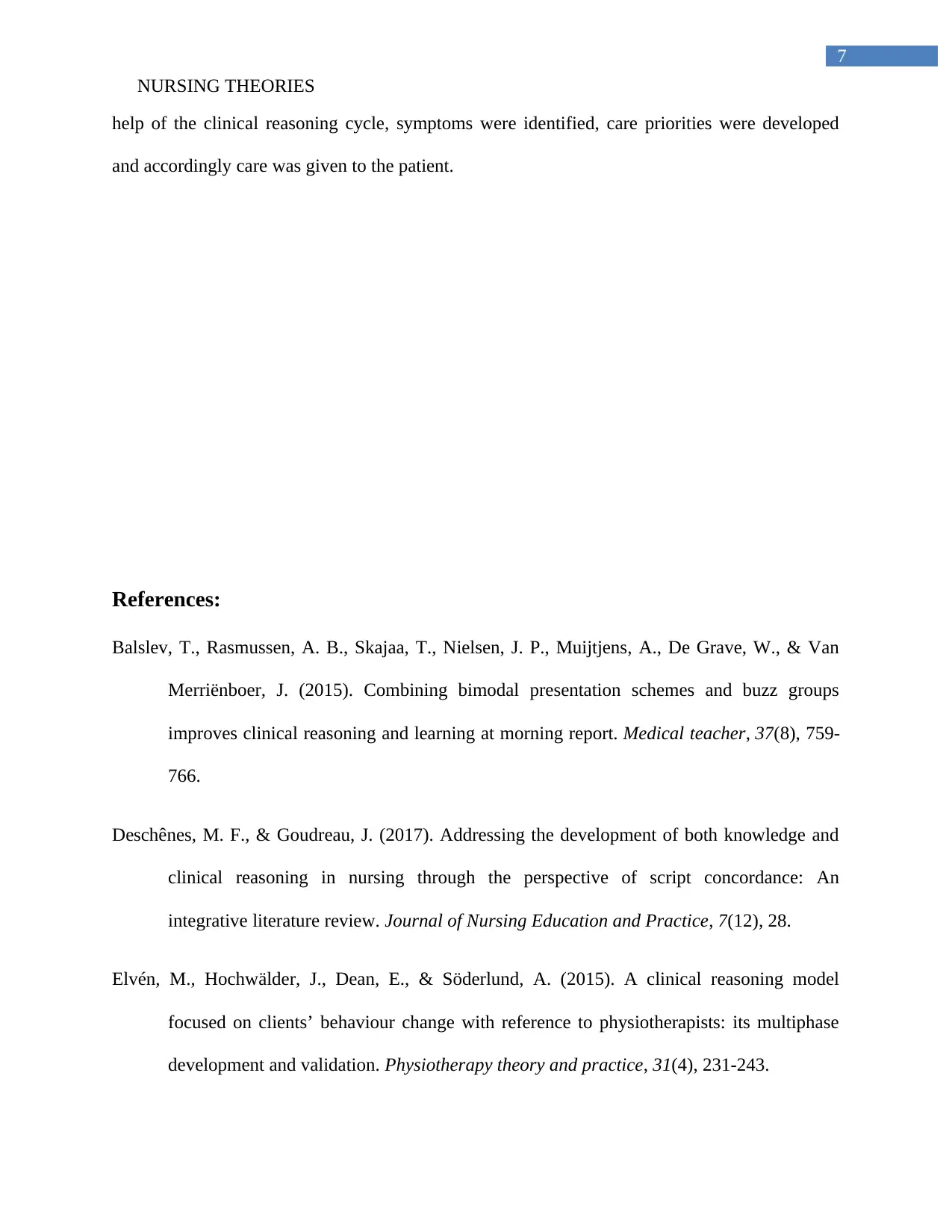
7
NURSING THEORIES
help of the clinical reasoning cycle, symptoms were identified, care priorities were developed
and accordingly care was given to the patient.
References:
Balslev, T., Rasmussen, A. B., Skajaa, T., Nielsen, J. P., Muijtjens, A., De Grave, W., & Van
Merriënboer, J. (2015). Combining bimodal presentation schemes and buzz groups
improves clinical reasoning and learning at morning report. Medical teacher, 37(8), 759-
766.
Deschênes, M. F., & Goudreau, J. (2017). Addressing the development of both knowledge and
clinical reasoning in nursing through the perspective of script concordance: An
integrative literature review. Journal of Nursing Education and Practice, 7(12), 28.
Elvén, M., Hochwälder, J., Dean, E., & Söderlund, A. (2015). A clinical reasoning model
focused on clients’ behaviour change with reference to physiotherapists: its multiphase
development and validation. Physiotherapy theory and practice, 31(4), 231-243.
NURSING THEORIES
help of the clinical reasoning cycle, symptoms were identified, care priorities were developed
and accordingly care was given to the patient.
References:
Balslev, T., Rasmussen, A. B., Skajaa, T., Nielsen, J. P., Muijtjens, A., De Grave, W., & Van
Merriënboer, J. (2015). Combining bimodal presentation schemes and buzz groups
improves clinical reasoning and learning at morning report. Medical teacher, 37(8), 759-
766.
Deschênes, M. F., & Goudreau, J. (2017). Addressing the development of both knowledge and
clinical reasoning in nursing through the perspective of script concordance: An
integrative literature review. Journal of Nursing Education and Practice, 7(12), 28.
Elvén, M., Hochwälder, J., Dean, E., & Söderlund, A. (2015). A clinical reasoning model
focused on clients’ behaviour change with reference to physiotherapists: its multiphase
development and validation. Physiotherapy theory and practice, 31(4), 231-243.
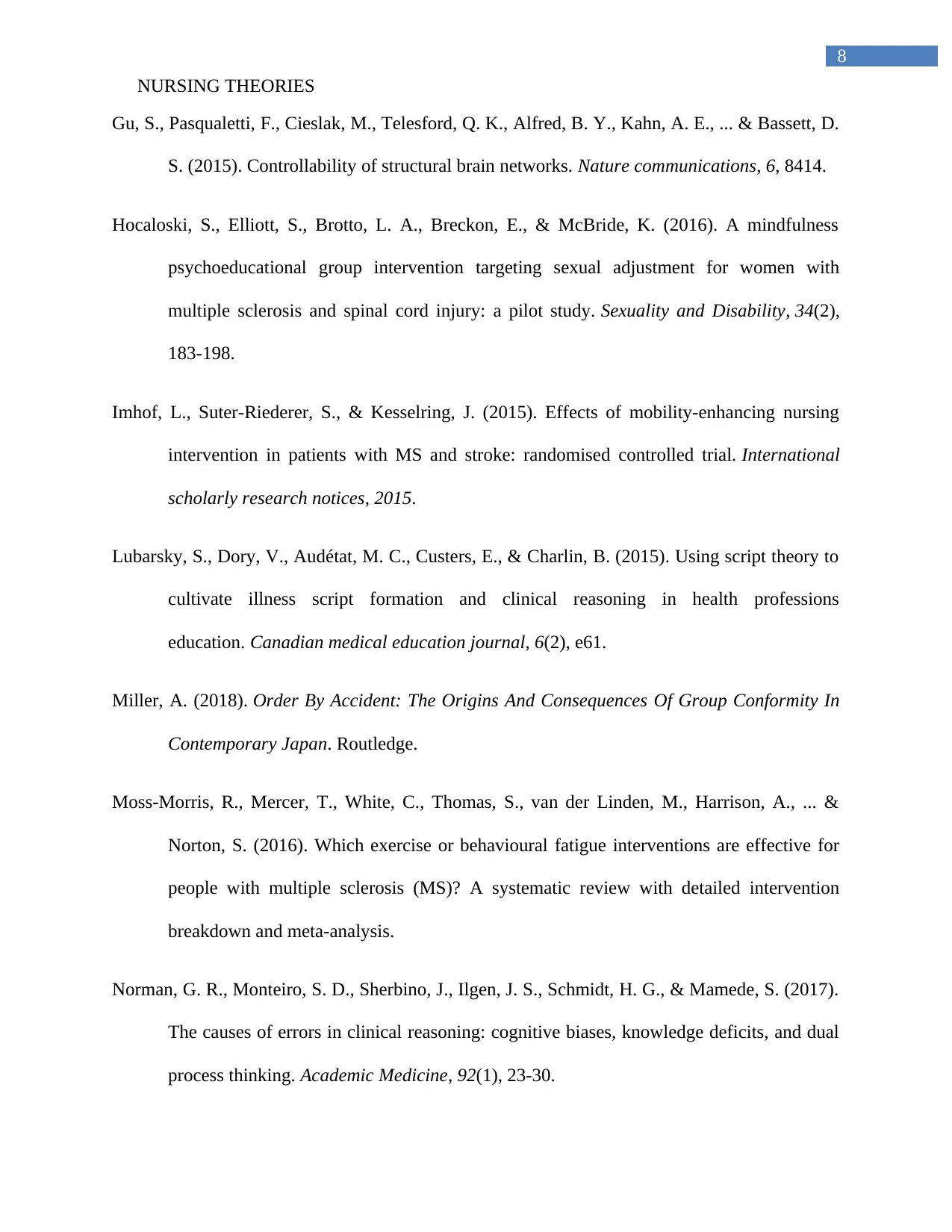
8
NURSING THEORIES
Gu, S., Pasqualetti, F., Cieslak, M., Telesford, Q. K., Alfred, B. Y., Kahn, A. E., ... & Bassett, D.
S. (2015). Controllability of structural brain networks. Nature communications, 6, 8414.
Hocaloski, S., Elliott, S., Brotto, L. A., Breckon, E., & McBride, K. (2016). A mindfulness
psychoeducational group intervention targeting sexual adjustment for women with
multiple sclerosis and spinal cord injury: a pilot study. Sexuality and Disability, 34(2),
183-198.
Imhof, L., Suter-Riederer, S., & Kesselring, J. (2015). Effects of mobility-enhancing nursing
intervention in patients with MS and stroke: randomised controlled trial. International
scholarly research notices, 2015.
Lubarsky, S., Dory, V., Audétat, M. C., Custers, E., & Charlin, B. (2015). Using script theory to
cultivate illness script formation and clinical reasoning in health professions
education. Canadian medical education journal, 6(2), e61.
Miller, A. (2018). Order By Accident: The Origins And Consequences Of Group Conformity In
Contemporary Japan. Routledge.
Moss-Morris, R., Mercer, T., White, C., Thomas, S., van der Linden, M., Harrison, A., ... &
Norton, S. (2016). Which exercise or behavioural fatigue interventions are effective for
people with multiple sclerosis (MS)? A systematic review with detailed intervention
breakdown and meta-analysis.
Norman, G. R., Monteiro, S. D., Sherbino, J., Ilgen, J. S., Schmidt, H. G., & Mamede, S. (2017).
The causes of errors in clinical reasoning: cognitive biases, knowledge deficits, and dual
process thinking. Academic Medicine, 92(1), 23-30.
NURSING THEORIES
Gu, S., Pasqualetti, F., Cieslak, M., Telesford, Q. K., Alfred, B. Y., Kahn, A. E., ... & Bassett, D.
S. (2015). Controllability of structural brain networks. Nature communications, 6, 8414.
Hocaloski, S., Elliott, S., Brotto, L. A., Breckon, E., & McBride, K. (2016). A mindfulness
psychoeducational group intervention targeting sexual adjustment for women with
multiple sclerosis and spinal cord injury: a pilot study. Sexuality and Disability, 34(2),
183-198.
Imhof, L., Suter-Riederer, S., & Kesselring, J. (2015). Effects of mobility-enhancing nursing
intervention in patients with MS and stroke: randomised controlled trial. International
scholarly research notices, 2015.
Lubarsky, S., Dory, V., Audétat, M. C., Custers, E., & Charlin, B. (2015). Using script theory to
cultivate illness script formation and clinical reasoning in health professions
education. Canadian medical education journal, 6(2), e61.
Miller, A. (2018). Order By Accident: The Origins And Consequences Of Group Conformity In
Contemporary Japan. Routledge.
Moss-Morris, R., Mercer, T., White, C., Thomas, S., van der Linden, M., Harrison, A., ... &
Norton, S. (2016). Which exercise or behavioural fatigue interventions are effective for
people with multiple sclerosis (MS)? A systematic review with detailed intervention
breakdown and meta-analysis.
Norman, G. R., Monteiro, S. D., Sherbino, J., Ilgen, J. S., Schmidt, H. G., & Mamede, S. (2017).
The causes of errors in clinical reasoning: cognitive biases, knowledge deficits, and dual
process thinking. Academic Medicine, 92(1), 23-30.
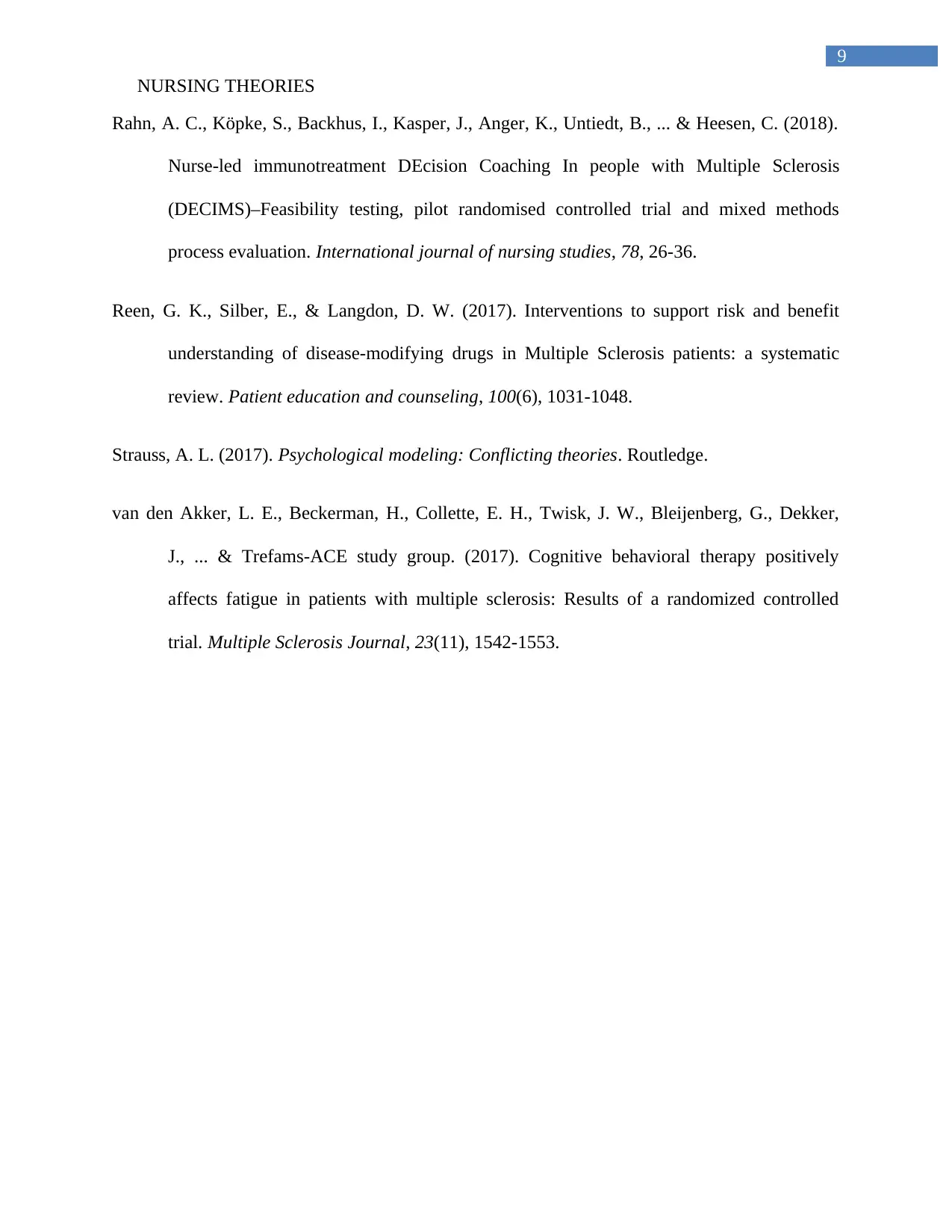
9
NURSING THEORIES
Rahn, A. C., Köpke, S., Backhus, I., Kasper, J., Anger, K., Untiedt, B., ... & Heesen, C. (2018).
Nurse-led immunotreatment DEcision Coaching In people with Multiple Sclerosis
(DECIMS)–Feasibility testing, pilot randomised controlled trial and mixed methods
process evaluation. International journal of nursing studies, 78, 26-36.
Reen, G. K., Silber, E., & Langdon, D. W. (2017). Interventions to support risk and benefit
understanding of disease-modifying drugs in Multiple Sclerosis patients: a systematic
review. Patient education and counseling, 100(6), 1031-1048.
Strauss, A. L. (2017). Psychological modeling: Conflicting theories. Routledge.
van den Akker, L. E., Beckerman, H., Collette, E. H., Twisk, J. W., Bleijenberg, G., Dekker,
J., ... & Trefams-ACE study group. (2017). Cognitive behavioral therapy positively
affects fatigue in patients with multiple sclerosis: Results of a randomized controlled
trial. Multiple Sclerosis Journal, 23(11), 1542-1553.
NURSING THEORIES
Rahn, A. C., Köpke, S., Backhus, I., Kasper, J., Anger, K., Untiedt, B., ... & Heesen, C. (2018).
Nurse-led immunotreatment DEcision Coaching In people with Multiple Sclerosis
(DECIMS)–Feasibility testing, pilot randomised controlled trial and mixed methods
process evaluation. International journal of nursing studies, 78, 26-36.
Reen, G. K., Silber, E., & Langdon, D. W. (2017). Interventions to support risk and benefit
understanding of disease-modifying drugs in Multiple Sclerosis patients: a systematic
review. Patient education and counseling, 100(6), 1031-1048.
Strauss, A. L. (2017). Psychological modeling: Conflicting theories. Routledge.
van den Akker, L. E., Beckerman, H., Collette, E. H., Twisk, J. W., Bleijenberg, G., Dekker,
J., ... & Trefams-ACE study group. (2017). Cognitive behavioral therapy positively
affects fatigue in patients with multiple sclerosis: Results of a randomized controlled
trial. Multiple Sclerosis Journal, 23(11), 1542-1553.
1 out of 10
Related Documents
Your All-in-One AI-Powered Toolkit for Academic Success.
+13062052269
info@desklib.com
Available 24*7 on WhatsApp / Email
![[object Object]](/_next/static/media/star-bottom.7253800d.svg)
Unlock your academic potential
© 2024 | Zucol Services PVT LTD | All rights reserved.





